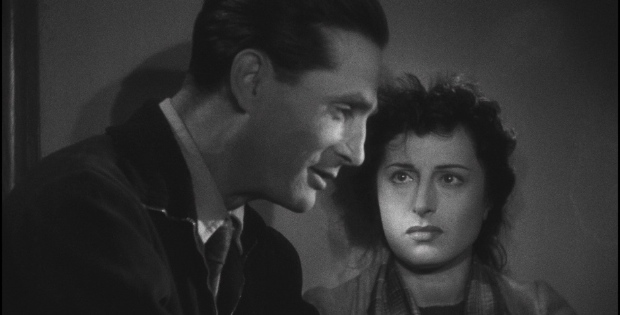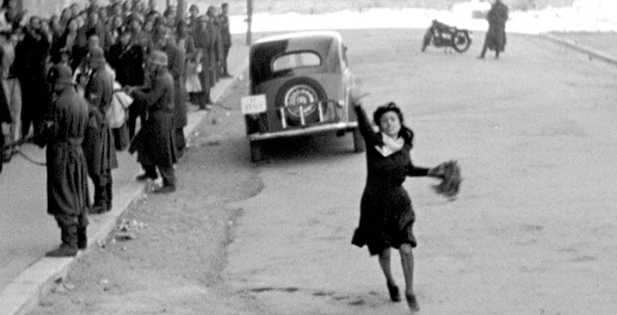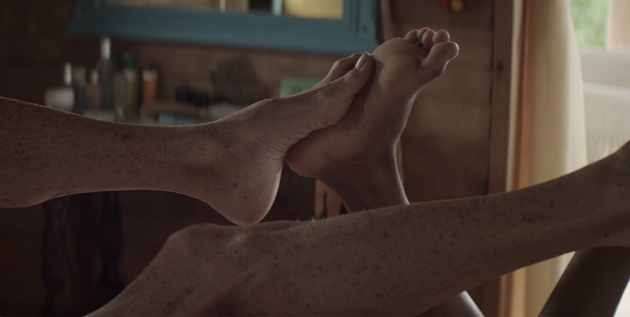
It was shortly after the Toronto International Film Festival this year when Kiva Reardon asked me if I had anything to contribute to this issue of cléo. I had just screened Sicario by Denis Villeneuve, a director with whom I’ve had the pleasure of working. There has been a lot of talk about Emily Blunt’s character in this film (she plays a law enforcement officer on the frontlines of the so-called war on drugs), and whether or not she attains any true agency. Often in cinema women hold contradictory roles fraught with tension— strong and self-possessed actors try to reconcile the archetypal images projected onto them by male directors. This made me think of Pina from Roberto Rossellini’s Rome, Open City (1945). Below is a condensed version of an essay I wrote while studying at the University of Toronto in the Cinema Studies department. It looks at the marginalized women of neorealism, but I think it pertains to many of the roles that women are given in contemporary cinema.
Italian neorealist films are revered for their social realism, from Luchino Visconti’s Ossessione (1942), to Vittorio De Sica’s The Children Are Watching Us (1943), or his Bicycle Thieves (1948), yet the figure of the Italian woman within the genre remains conflicted and confined to the realm of masculine fantasy. If neorealism is rationalized by its practitioners as a way of conveying truths about reality, then it is significant to deconstruct and define whose reality is being represented. I look to the women of Roberto Rossellini’s landmark neorealist film Rome, Open City (1945) as a way of asking whose life, whose struggle, whose identity is granted this social realism? For Rossellini and other screenwriters and directors of his time, the Italian experience that neorealism so longs to capture is decidedly that of the Italian man.
Rome, Open City has been canonized as the ultimate example of neorealism for both its aesthetic and theoretical techniques. That is, the film embodies the urgency and immediacy of the neorealist movement in both form and content. Rossellini began shooting in January 1945 amidst the war, forcing him to be resourceful. He used salvaged film stock, he shot in abandoned basements, post-synchronized sound, and, like the characters in Rome, Open City who were tormented by war, Rossellini himself had to fight for his political and artistic vision.[i] With plot lines inspired by true events, Rome Open City begins to test the traditional constructions of femininity, but it falls short of creating any real friction. Women remain defined only in relation to their male counterparts, and their experience is not held up to political scrutiny, but rather subordinated to masculine agency.
Rome, Open City is motivated by the conflict between Nazism and Fascism on the one hand, and the Italian Partisan Resistance on the other. Manfredi (Marcello Pagliero), a Communist Resistance leader, and Don Pietro (Aldo Fabrizi), a Partisan priest, embody the noble and collective struggle against a totalitarian regime. In contrast, the film’s two female characters, Pina (Anna Magnani) and Marina (Maria Michi), are portrayed as the casualties of Nazi injustice and cruelty. In Women, Desire, and Power in Italian Cinema (2010), Marga Cottino-Jones suggests that while male characters acquire their significance through their political autonomy— waving the flags of collective resistance— female characters are granted importance through their victim status. This image of the weak woman allows the audience to sympathize for them instead of empathize with them. Pina proves to be one of the most contradictory female characters in neorealism, as she is the only woman to achieve hero status. By looking closely at her heroism in the film, we can uncover the contradictory nature of the Italian female identity in the postwar context. While Pina is granted the status of hero, it is only because she is the catalyst for the film’s political message of solidarity (55).
As a way of characterizing Pina as the film’s heroine, Rossellini introduces her in the middle of the bread riot. Frustrated by a baker who sells to Fascist customers, Pina, in solidarity with other outraged women, storms the bakery in a scene of vigilante justice. She leaves the riot with a modest amount of bread, and without hesitation gives a loaf to her hungry companion, an Italian police officer. In this short sequence, Rossellini intentionally casts Pina in two typically masculine roles: the bread winner and the hero who steals from the rich and gives to the poor. Pina is shown as a modest, kind, and proactive heroine; at the same time, however, Rossellini undermines her heroism with conflicting identities. He chooses to shoot the bread riot sequence in a medium length, two-shot in order to portray Pina as a heroine of the people. While a singular close-up shot could reinforce her autonomy, Rossellini emphasizes her lack of individualism by consistently framing her in two-shots. The medium length shot also allows the camera to emphasize her pregnant figure. The initial image of the full-bellied Pina casts her as the archetypal mother (the Madonna)—all loving, and all giving. At the same time, by accentuating her pregnancy, Rossellini undercuts Pina’s hero status by offering a visual reminder to the audience of her maternal responsibilities. The director thereby burdens his heroine with the gendered expectation of motherhood in the moment of her triumphant act.
Rossellini continues to contradict Pina’s status as an autonomous hero in her death sequence. Pina and the other apartment residents have been evacuated by Nazis and are lined up outside while officials search for Resistance leaders. When she spots her fiancé Francesco (Francesco Grandjacquet) being taken away by officials, she breaks free from the crowd to pursue him. As she runs out of the courtyard and onto the street, Rossellini switches the camera’s perspective to a frontal full length shot of Pina running after the truck. The camera is placed on the truck from Francesco’s point of view and Pina’s forward movement is in unison with the truck’s motion away from the crowd. Pina is shot by the Nazis for this rebellious act and she collapses suddenly to the ground. The camera, still on the truck, continues its receding movement and Pina’s dead body shrinks smaller from Francesco’s perspective. As Cottino-Jones notes, the camera placement in this shot sequence emphasizes the gratuitous nature of the violence and the thoughtless cruelty of a regime capable of murdering a pregnant woman. While Pina temporarily defies the Nazis by chasing after Francesco, the tragedy of her murder is that she dies for romance, not the political injustice that enraged her.

Rossellini accentuates the futile nature of Pina’s death by having Francesco escape only moments later in the following scene. In contrast to the other male heroes who are murdered, Manfredi and Don Pietro die exclusively for their political and ideological causes, which are rooted in a notion of a collective struggle.[ii] In this sense, the vision of Pina as the film’s real hero is clouded by traditional archetypes of the apprehensive mother, the culturally-valuable pregnant woman, and the defenceless lovesick female. Mirroring postwar concerns about women and their place in Italian society, Pina symbolizes the tension between burgeoning female independence and traditional female roles. She is sacrificed for Manfredi, the man who remains the film’s only surviving hero.
The other female characters in Rome, Open City, Marina, Laurette (Carla Rovere) and Ingrid (Giovanna Galletti), fit into the narrow categories of femme fatale or villain, challenging familial expectations and threatening masculinity through their independence. [iii] Even as they strive to attain financial autonomy and power, Rossellini sadistically condemns each character. In opposition to Pina, Marina refuses to conform to the traditional patriarchal female roles of wife and mother because she sees marriage and motherhood as a loss of financial freedom. She refuses any form of emotional or political commitment for fear of being condemned to the extreme poverty she was raised in. Instead, Marina invests all of her self-worth in the material possessions associated with economic agency. In a similar vein, Laurette is envious of Marina’s financial position and strives for the same material luxuries, while Ingrid is cold, calculating and relentlessly evil. Combined, these women’s materialistic desires serve as a cautionary tale to a burgeoning consumerist culture—their demise is a reminder that women are punished and objectified for their frivolity. Thus, Pina’s character seems particularly unusual in contrast to the other women of Rome, Open City, further confirming the rarity of her status as hero.
Rossellini uses Ingrid to confirm the view that a woman must sacrifice her femininity and virtue as a means to attain power. While Marina and Laurette are presented as victims to be pitied, Ingrid is harshly judged. Through Pina and Ingrid, Rossellini proves that he is capable of expanding traditional cinematic definitions of femininity, yet all the women in Rome, Open City are victims of some form of masculine oppression and are explicitly condemned for their excesses. Whether it be for love in the case of Pina, for material possessions in that of Marina and Laurette, or for power in that if Ingrid, Rossellini ensures that each woman suffers for daring to desire. [iv]
While film critics have worked to define and categorize the movement, few of them have placed the necessary significance on the treatment and slim definition of women in neorealist films. The postwar context was a time of major transition for the Italian woman and as a result, women were often prescribed contradictory roles with conflicting expectations. Although the female struggle is marginalized by directors like Rossellini, their characters exceed their creators and prove to be diverse, controversial, and essential to an understanding of Italian neorealism.





